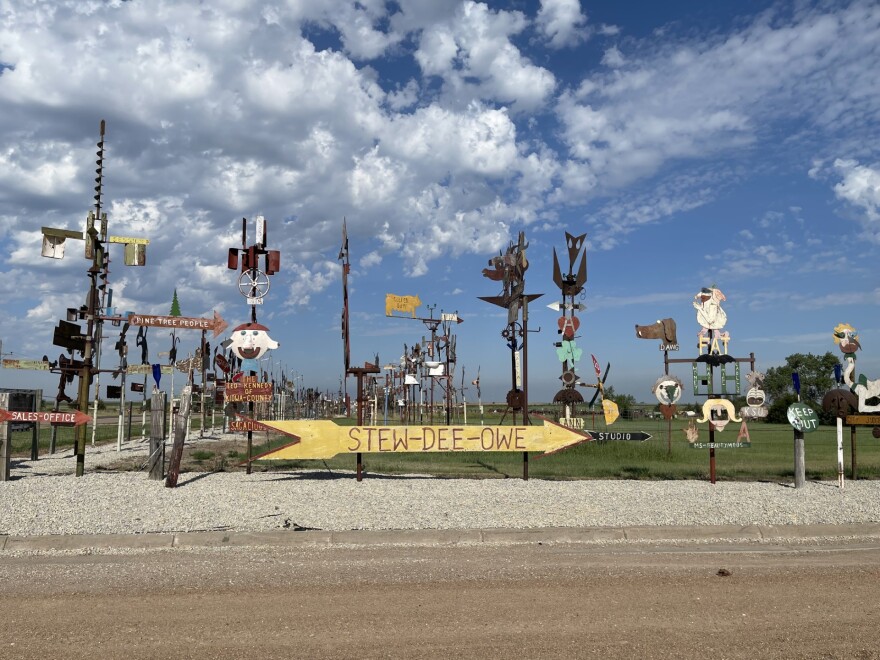MULLINVILLE — Although it’s been seven years since grassroots artist M.T. Liggett died, people have never stopped coming to town to see his artwork.
Last year, more than 2,000 visitors pulled off the highway to see the pastures lined with hundreds of Liggett’s whirligigs and his quirky — and most often-times politically incorrect — totem pole sculptures.
A new visitors center in Mullinville includes exhibits and displays on Liggett. But it also houses an artist-in-residence program, and it continues the preservation process that will keep Liggett’s work intact for future generations.

The preservation process began in April 2019 and was funded and directed by the Wisconsin-based Kohler Foundation — the same family whose company is known for its plumbing products.
The foundation preserves art environments on a national basis and has already helped preserve two other grassroots art projects in Lucas, Kansas: Samuel P. Dinsmore’s Garden of Eden, and Roy and Clara Miller’s Park.
“After M.T. passed away … his Trust contacted the Kohler Foundation for the Arts out of Sheboygan, Wisconsin. And they committed to preserve all of his work and became very involved in the building of this wonderful visitors center,” said Ann Dixson, director of the 547 Art Center at Greensburg. The center owns and manages the M.T. Liggett Art Environment in Mullinville.
The Liggett Visitors Center looks more like a cross between a barn, house and studio. It's comfortable. Zany. And every bit as quirky as the artist himself, whom The New York Times, in his 2017 obituary, called an “art provocateur.”

Liggett’s original combination studio and shed – he called it his “Stew-Dee-Owe” — was razed in 2019 because it was often a tripping hazard, filled with thousands of coffee mugs and art materials.
Liggett was so well known that in 2001, The Wichita Eagle reported that as many as 100 vehicles a day pulled onto the paved shoulder of either U.S. 400 or U.S. 54 to gawk and take pictures of his artwork. That concerned local and state officials and led the Kansas Department of Transportation to install “emergency parking only” signs there.
In fall of 2013, Liggett was featured on the History Channel’s “American Pickers.” Liggett told The Eagle he acted like himself when TV cameras came rolling into Mullinville.
“I'm sure there are going to be a lot of bleeps,” he said. And there were.
The new visitors center remains true to Liggett’s essence. There are interactive videos that tell the stories of Liggett from people who knew him well – relatives, friends, Mullinville residents, as well as people from the art world.

“Everything that was in M.T.’s shop, including his cup collection of over 6,000 cups, his tools, his other collections are inside this visitors center and shared,” Dixson said. “The exhibit that we have here explains the good, the bad and the ugly of M.T.’s life story. The exhibit talks about his early years, his art and his loves of life – his different relationships.”
Indeed, there were a few relationships that provided his artistic muse. On display are four wedding rings – for his first wife, Loeta Faye Snow; second wife, Pauline Whaley; Barbara Stewart; and 6th wife, Patsy Anne Micou.
There are tools and coffee mugs. Overalls and T-shirts.
He called his work “Disco Art Works, Manufacturer of Political Statement Totem Poles.”
Folks in Mullinville, a town with fewer than 300 people, would, at times, roll their eyes in exasperation at Liggett.
“M.T. would poke people a lot and sometimes it could be harmful. It could be damaging,” Dixson said. “There’s still some folks in the local community that … have ill feelings because of pain that they suffered.
“But, on the other side, M.T. would poke people to get them to think. He never wanted people to become complacent in their viewpoint.”

Dixson said Liggett was “one of the most complex people I ever knew.”
“He had a very big heart, and he didn’t want people to really see that, a lot of the time. “He was inventive. He was brilliant. He was an instigator. He was a thinker.
“He loved history and philosophy and not only art. Many of those things — the multifaced views of his life — came out in his creations.”
Liggett was indeed controversial — but there was no denying he was also a well-known artist.
Last year, visitors from 46 states and eight countries came to see his artwork. And the visitors are having an impact on the local economy, Dixson said, through people eating at the town café and buying mementos.
And in his own way, Liggett would have enjoyed that.








